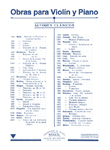WORKS
- Genre
-
Musical education
- Choir
- Counterpoint
- Dictation
- Direction
- Exam study manuals
- General music pedagogy
- Harmony
- Hearing
- Illustrations / Posters
- Improvisation / Sight reading
- Instrument methods
- Instrument pedagogy
- Instrumental study repertoire
- Instrumentation and orquestration
- Musical language
- Solfège
- Templates
- Theory and analysis
-
Incidental music
-
Lined paper
-
Flamenco
-
Religious music
-
Classical / contemporary
-
Modern music
-
Folk music / traditional
-
Musicology
-
Divulgation
-
Games and hobbies
-
Music therapy
-
Children / Youth
-
- Instruments
- Ensemble
- Difficulty level
- Period
- Genre
SOPORTE
Search
Find here: books, scores, composers, digital pieces, cd's
Best-selling works
Our classics

Newsletter
I wish to be informed of the news about your music
We have received your e-mail correctly
Multimedia
Partita Flauta Solo BWV1013
Addendum con Basso continuo e Partitura-studio
Flauta
BACH, Johann SebastianBACH, Johann SebastianBACH, Johann SebastianReg.: EI0319
19,80 €
P.V.P. (VAT included 4%)
Add to cart
- Review: BROLLI, Marco
- Ensemble: Duos: With piano.
- Genres: Classical / contemporary: Solos; Chamber.
Musical education: Instrumental study repertoire.
- Language of the comment: Spanish, Italian, English
- Product format: Partitura + particellas
- Difficulty level: Intermediate-advanced
- Period: Baroque
- Publishing house: Editorial Boileau
- Collection: Ibérica
- No. of pages: 40 + 32
- Measure: 31,00 x 23,00 cm
- Lenght: 9'10"
- ISBN: 978-84-17199-59-3
- ISMN: 979-0-3503-3990-5
- Available in digital: No
- Available for rent: No
The commonly called Partita in A minor of J. S. Bach, whose original title is Solo pour la Flute traversiere, has been and continues to be a constant subject of study by a range of people: from the musicologist (for a historic-philological research) to the conservatory student (for a technical and performing practice). This attention is absolutely justified by the undoubted high artistic level of the piece and by its characteristic writing style that makes itself an «unicum» in the solo-flute literature of the first half of the 18th century.
Consequently to all I hitherto wrote, I considered appropriate to add a through bass (basso continuo) part to the musical text of the Partita. I made it in a two staves system: in the lower staff I put the figured bass line and in the upper staff I wrote its chords realization, in order to get an easier view of the harmonic texture and also for an immediate performance with a keyboard instrument as accompaniment. The basso continuo I created is not a new added independent contrapuntal line, because this piece really does not need it. I instead wrote a reasonable harmonic support like a summary of the flute part, underlining a very important item: the harmonic rhythm.
My idea of adding a through bass to the solo-flute Bach’s Partita gets a two steps target: the theoric phase, analyzing the whole piece through the harmony; the practical phase applying all the earlier analized aspects to the final performance.The three items we have to pay attention are: breathing, dynamics and articulation.
This score includes also a Practice-Score with the armonic rythm and the more relevant beathing.
Marco Brolli







